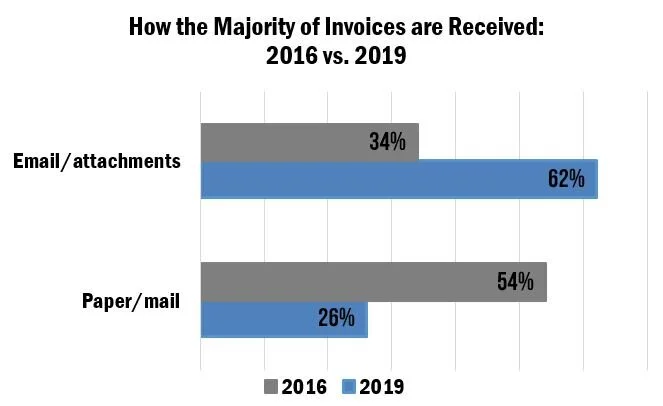Discussing payment terms with suppliers is a best practice, but ensure your organization does not overlook other important aspects of the purchase-to-pay process; namely, invoices. Clarifying invoice-related specifics up front with suppliers can minimize common pain points for accounts payable, saving time and money. One such topic to address is invoice delivery (the method, as well as to whom an invoice should be sent). Recent survey results from AP Now reveal an interesting invoice development that all organizations should effectively manage. Keep reading to see what it is and steps your organization should be taking.
Invoice Delivery
Per the Accounts Payable in 2020 survey results by AP Now, emailed invoices have surpassed mailed/paper invoices as the most common way organizations of all sizes receive invoices. This is a notable change from just three years ago, as shown below. Can you guess what problem has increased along with it?
As the popularity of emailed invoices has risen, there has been a significant uptick in the receipt of duplicates; 66% of survey respondents specify duplicate submission of invoices as an issue they regularly encounter, compared to 50% who noted the same back in 2016. The only problem cited by a higher percentage of respondents (69%) is invoices that are missing a PO number and/or requisitioner name.
Email makes it easy for suppliers to send the same invoice more than once, whether to multiple people (e.g., the buyer and AP) or the same person/entity, but, for your organization, duplicate invoices drain AP’s time and increase the risk of duplicate payments.
Best Practices for Emailed Invoices
AP Now recommends the following:
Establish a designated, generic AP email address for invoice receipt (e.g., invoices@ABC-company.com).
Educate suppliers about the process and contact any that send more than one copy of the same invoice.
Adhere to a consistent protocol for saving and entering invoices to help prevent duplicate payments.
Do not print emailed invoices; instead, consider providing two screens for invoice processors.
As another best practice, I recommend educating internal buyers, so they don’t direct suppliers to send invoices to them.
Final Thoughts
Along with education, I stress documentation. Key parts of the desired purchase-to-pay (P2P) process should be noted in a contract or, at a minimum, an email. If, down the road, your organization changes a significant part, documenting the changes (e.g., amending the contract) is a wise step to reinforce the new process. Buyers, AP, and suppliers alike benefit from smooth operations.
Available Products & Services from Recharged Education
Submit a contact form to request a quote for what your organization needs.
Subscribe to the Blog
Receive notice of new blog posts.
About the Author
Blog post author Lynn Larson, CPCP, is the founder of Recharged Education. With 20 years of Commercial Card experience, her mission is to make industry education readily accessible to all. Learn more…


